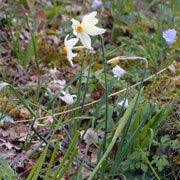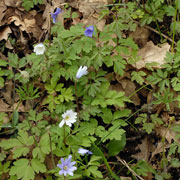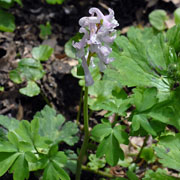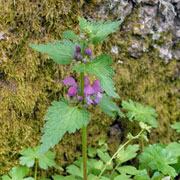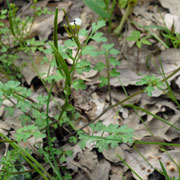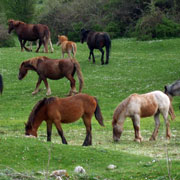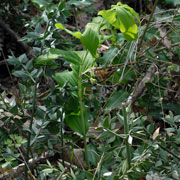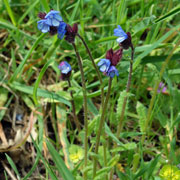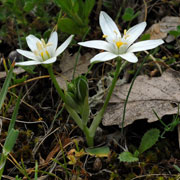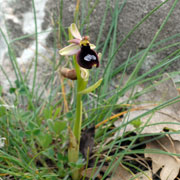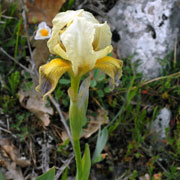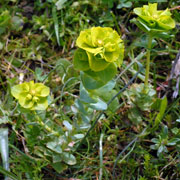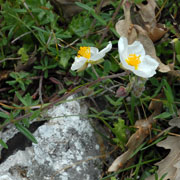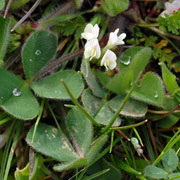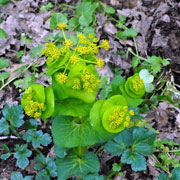We searched for a roadside bank which had been seen by one of our leaders on a recent reconnaissance visit and eventually found it. It was covered in Narcissus poeticus (Pheasant's-eye Narcissus). This is a often used for plant in spring flower beds so we know it well but there is something special about seeing it in its natural habitat. There were a few orchids too and we identified Ophrys garganica (Gargano Orchid) without help from our leader this time. In the woods there were tall yellow daisies which were similar to our common Leopard's-bane (Doronicum pardalianches) but it had the "wrong" leaves. This species was the Heart-leaved Leopard's-bane: Doronicum columnae. Drifts of Blue Anemone Anemone apennina were among the Narcissi together with the occasional darker and taller Anemone hortensis (No English name). I found and photographed a white Crucifer (never good news for a botanical leader) but none of us could identify it there and then. It turned out to be Thlaspi praecox through matching the flowers, leaves and most important of all with crucifers, the fruit from the photograph.
Thlaspi praecox shares an interesting characteristic with our well-known Alpine Pennycress (Thlaspi caerulescens). Both will grow on slag heaps particularly near metal ore mines in conditions which are poisonous to many other plants. Both plants accumulate heavy metals without affecting the plant's growth or vigour.
With so many beautiful and interesting species we could easily have missed the tiny white flowers of Saxifraga tridactylites (Rue-leaved Saxifrage) which were dotted here and there amongst the rocks. However if you are used to botanising in the early British springtime you should be quite used to looking for tiny, superficially insignificant flowers like Teesdalia nudicaulis (Shepherd's-Cress, Cerastium semidecandrum (Little Mouse-ear) or even Mibora minima (Early Sand-grass) compared with which Saxifrage tridactylites is is a good sized species.
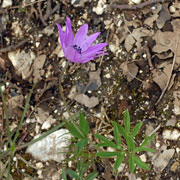
|
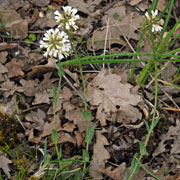
|
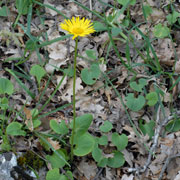
|
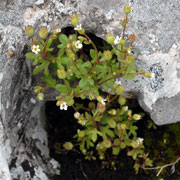
|
| Anemone hortenisis No English name | Thlaspi praecox No English name | Doronicum columnae Heart-leaved Leopard's-bane | Saxifraga tridactylites Rue-leaved Saxifrage |
In the Bosco Quarto Forest Stop 5
We had one final stop before lunch to see a special plant which prefers the shade. Under the trees the pale yellow flowers of Dactylorhiza romana (Roman Orchid) added another to our our growing list of orchids seen on the Gargano. We also found one young undeveloped stem of Limadorum abortivum (Violet Bird's-nest Orchid) which is a deep violet saprophytic orchid plant with no green leaves. Such plants live of rotting organic matter rather than making their own carbohydrates through photosynthesis. This allows them to live in deep shade as they have no need for sunlight. This plant was too young to see any definition other than a purple stem and unfortunately we could find no others and I for one looked very hard indeed. Low on the ground were some odd looking things which looked like miniature insectivorous pitcher plants. These were Aristolochia rotunda (No English name) and much smaller than the large climbing species: Aristolochia baetica (Dutchman's-pipe) of southern Spain which I found in 2008. Also some small yellow plants which I mistook for Duchesnia indica (Yellow Strawberry) were actually Aremonia agrimonioides (Bastard Agrimony). This is an escape in the British Isles and it grows in shade close to the Thames near Kew. I have seen it several times without flowers and so now I know what to look for.
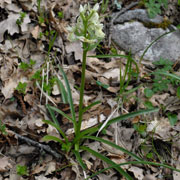
|
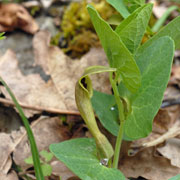
|
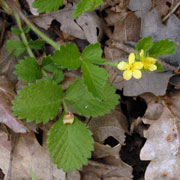
|
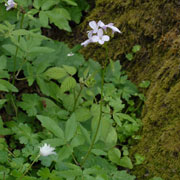
|
| Dactylorhiza romana Roman Orchid | Aristolochia rotunda No English name | Aremonia agrimonioides Bastard Agrimony | Cardamine bulbifera Coralroot |
Lunch in the Forest Stop 6
We stopped at a clearing in the Forest where there were picnic tables and there was even a little occasional sunshine. The usual feast was made available and we sat down at tables in the peace of the forest hearing only the birds and our own quiet conversation. The Grappa came out again just in case the weather turned a touch Scottish again. I have to admit that I should really have volunteered to help with the meal preparation but with so many other willing hands I just went A.W.O.L. botanising around the picnic site.
I soon found a large pink corydalis which I've never seen in the wild before but recognised from the pictures in the book. It was Corydalis solida which has the interesting English name of Bird-in-a-Bush. I can't find any reference to how the English name arose but Corydalis does come from the Greek meaning Crested Lark referring to the flower shape. Since Corydalis solida does grow in the forest this could be the "bush".
Also known as Fumewort in the United States, this is a poisonous plant but it can have deep lilac coloured flowers as well as pink. Nearby there was a large deadnettle, slightly paler than our British Red Deadnettle (Lamium pupureum) but much taller and stouter. Having seen something like this in Slovenia I wondered if it was Lamium orvala but this one was Lamium garganica (Large Red Deadnettle). A tall pink crucifer was flowering dotted all over the forest floor wherever light dappled through the leaves and I have seen this one before but only in fruit so didn't recognise it. It was Cardamine bulbifera (Coralroot) which produces black bulbils rather than seeds after flowering.
A forest walk in the afternoon sunshine Stop 7
So far we'd had to wear over-trousers and waterproofs for most of the time but as we walked through the forest after lunch the hot southern Italian sun came out for longer periods of time (i.e. about 20 minutes) forcing us to strip off. On this very pleasant walk we found Cardamine plumieri (Ivy-leaved Bittercress) on the verges, Polygonatum multiflorum (Solomon's Seal) on a hedge bank and a delightful patch of Anchusa cretica (No English name). At the side of the path there were quite a few small shrubs with sharp pointed "leaves" and dead flowers in the centre. This was Ruscus aculeatus (Butcher's-broom) which had long since finished flowering. The leaves are actually bracts and you can just make out a dead flower in the centre of a bract on the left-hand side of the Polygonatum multiflorum photograph.
The butterflies were out enjoying the warmth too and we saw plenty of Orange tips (Anthocharis cardamines), a Swallowtail (Papilio macheon) and various blue butterflies which never settled. Eventually the path led to a barbed wire fence where we met the landowner. He went to his car and brought some tools to cut the wire of his own fence so we could get through! What are the chances of and English farmer being so accommodating to a party of Italian walkers who have taken wrong turn?
Approximately nil.
They'd probably be threatened with shouts of Get orff my land! and the waving of shotguns. (As you can tell my relations with farmers have not always been too cordial. At various times over the years we have had two herds of cows, several sheep and half a dozen frisky ponies wander into our garden doing considerable damage to the grass and flowerbeds. When this happens it is apparently what I should reasonably expect living in the countryside but if I tread an inch on a farmer's land then it's definitely trespass.)
We walked down the road passing some cows, a herd of horses and a pond covered with Water Crowfoot when our bird expert Joe saw a Yellow Wagtail (Motacilla flava). I'm no good at moving from sighting a bird to using binoculars but with Joe's coaching we got a superb view of these lovely birds. As usual he gave as a commentary about which sub species they were.
I'm afraid there are no photos of the birds we saw as we would have had to carry cameras and a digiscope around with us. Joe's knowledge of birds and their flight and song was very impressive. He would comment on the Blackcap (Sylvia atricapilla) singing to our left, the Nightingale (Luscinia megarhynchos) in the valley and when a black dot rushed by at great speed it confidently identified as a Sub-alpine Warbler (Sylvia cantillans). Being a head-down or bum-in-the-air botanist, I tend to miss the birds without an expert prompter like Joe.
It clouded over a little but as we climbed back up the hill to our vehicles we came across an open hillside similar to the ones we had seen the day before. It was full of botanical treasures and almost immediately we found the uncommon Ophrys bertoloniformis (No English name) which in my photograph looks like a cross between a flying duck and legless tarantula. Also on the hillside were Ornithogallum montanum (No English name), large numbers of Iris lutescens (No English name) including some pale yellow ones, Euphorbium myrsinites (Broad-leaved Glaucous Spurge), Trifolium subterraneum (Burrowing Clover) and Helianthemum apenninum (White Rockrose). Just before arriving back we found a Smyrnium species. This was probably Smyrnium rotunda but I'm not absolutely sure never having seen this before and it is very similar to Smyrnium perfoliatum. Both are related to Alexanders (Smyrnium olusatrum) the common seaside umbellifer which flowers in very early spring in Britain with huge umbelliferous greeny-yellow flowers.
This had turned out to be good day after a poor start and we travelled back with confidence that the weather was changing for the better and we could look forward to the use of hats and serious discussions about sun stroke prevention.


